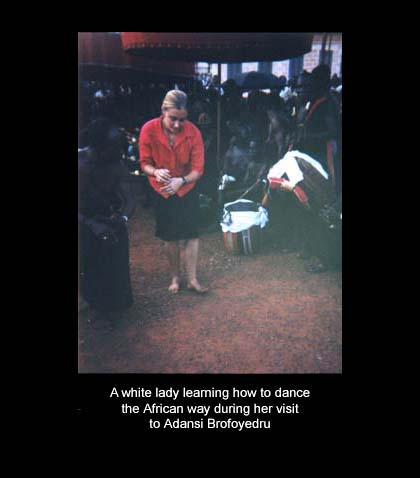Our Village The history of Adansi Brofoyedru village |











It was in 1650, that the first ancestors of the village known today as Adansi Brofoyedru, descended down the Meyeme scarp to be the first settlers of the land. Legend has it that they had made a long and arduous odyssey through the Bonsra forest. Bonsra forest is located in Adansi of the Ashanti region of Ghana. In the seventeenth century, the forest was very thick and filled with a variety of dangerous animals. So arduous was the journey of these brave men and women that the forest claimed some of them. They were worried of the bloody tribal conflicts and poor harvests that occurred on a rampant basis in their village, so they decided to brave through the forest for a better place where they could settle and start a village on their own. Those who survived the journey were fortunate to discover what they deserved; good land for settlement. They were impressed by their new environment. On the left side was the Kusa scarp, which connected to the Meyeme scarp on the front, with the Dampaya scarp extending all the way to the far right. They realized they were obviously in a wide valley, thus, after thanking the gods of their new land and the Supreme God through libations, they named their new settlement Adansi Monsie. Monsie in Ashanti means valley. Over time, Adansi Monsie’s population increased, and farming and hunting were the predominant activities of the villagers. On some occasions, they fought to defend their village from enemies of that time. Although, they were successful and always retained their village, such wars took heavy tolls on them. During one such war, the royal family, whose duty it is to provide a chief for the village, lost three strong men. These men were buried near Maame Adwoa Ampofoa’s house. Their graves are visible to this day.
Watch the Village slideshow
|
Over time, Adansi Monsie became an important village. It developed a Zongo community, where people from the Northern part of Ghana, who were of the Dagomba and Wangara tribes, settled. What contributed to its importance was its location. The village served as a connection between Cape Coast and Elmina, coastal towns in southern Ghana, and Kumasi, the capital of the Ashanti nation. European goods were traded from Cape Coast through Adansi Monsie to Kumasi. The British, in the nineteenth century, were the dominant Europeans in Ghana, and their effort to colonize the Ashantis was met by heavy resistence over a long period of time. In 1896, the British arrested Nana Akwasi Agyeman Prempeh I, king of the Ashanti nation, his immediate family and several important chiefs. They were exiled to Elmina, then to Sierra Leone, then finally to the Seychelles Islands. On the way to Elmina, the British, with the king of Ashantis, passed through Adansi Monsie. The great king of the Ashanti nation, whilst in Adansi Monsie, was surprised that the British had been successful in arresting him, considering the power he wielded, and the war strength of the Ashanti nation. In his surprise, he said “Brofo ye dru” which translate in English as “Whites are strong.” The then chief and people of Adansi Monsie village, to honor the Ashanti King, who was head of their nation, changed the village’s name to Adansi Brofoyedru.
Adansi Brofoyedru continued to be a link for traders from the coastal part of the country to the inner parts through the nineteenth century. This brought big stores such as G.B. Ollivant, U.A.C., U.T.C. to the village. However, when Ghana achieved independence from British rule in 1957 and roads were constructed through other routes, these stores folded up.
Some of the powerful chiefs who ruled Adansi Brofoyedru in the past were Nana Tenkoran Asante, Nana Kweku Gyamera, Nana Owusu Appiah, Nana Owusu, Nana Kwasi Dawu. Some of the village’s past chiefs were war chiefs, who acted as generals, to defend and retain the village. The current chief of Adansi Brofoyedru is Nana Amoako-Kosare Diamim II. He ascended the paramount throne in 1979, fulfilling a prophecy believed to had been made whilst he was still in the womb of his mother, Obaa Yaa Kuma Auntie. Through the efforts of him and his elders, electricity was connected to the village in 1993. Before becoming a chief, he was a sergeant with the Ghana Army. He served in Lebanon through the United Nations Peace Keeping Mission in the 1970s. Several children in America and Ghana continue to be named after him, primarily because of his unique character. He is unselfish, an altruist, and he is worthy of emulation.
Adansi Brofoyedru village has come a long way to acquire three basic schools, but none of these schools has a library. Through solicitations for financial help, Ardent Lion Society, a not-for-profit organization, is helping Adansi Brofoyedru village build a library.
